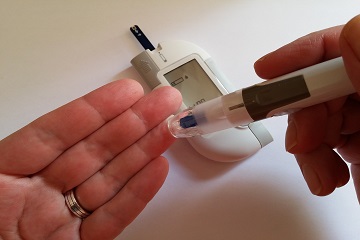Diabetes facts
Diabetes is a chronic disease that occurs when the pancreas is no longer able to make insulin, or when the body can’t make good use of the insulin it has.
Insulin is a hormone produced by the pancreas that transforms the glucose found in the food we eat into energy. Not being able to produce insulin or use it effectively leads to raised glucose levels in the blood.
 Taking diabetes seriously
Taking diabetes seriously
There’s no such thing as ”mild” diabetes. Diabetes is always serious. If it’s left untreated or isn't managed well, the high levels of blood glucose associated with diabetes can slowly damage both the fine nerves and the small and large blood vessels in the body.
If you’re over 35 and have any of the risk factors, you should be tested every year. A simple finger-prick test at your local pharmacy or clinic can diagnose the strong likelihood that you may have diabetes within a minute.
You also need to know what the symptoms of diabetes are and whether you're at risk.
Symptoms of diabetes
- frequent urination,
- excessive thirst,
- increased hunger,
- unusual weight loss,
- tiredness,
- lack of interest and concentration,
- blurred vision,
- frequent or recurring infections,
- cuts and bruises that are slow to heal, boils and itching skin,
- tingling and numbness in the hands or feet, and
- vomiting and stomach pain (often mistaken as the flu).
If left untreated it can lead to a variety of complications, including:
- heart disease
- blindness
- amputation
- depression, anxiety and distress
- kidney disease
- erectile dysfunction or impotence
The good news is that with careful management, these complications can be delayed and even prevented, but early diagnosis and going for regular blood glucose testing is very important.
Premier Alan Winde urges citizens to have themselves tested for diabetes:
Understanding what glucose monitoring is and where to get the equipment

Glucose monitoring is a simple glucose test that can be done at home with a glucose monitor (known as a glucometre).
All leading pharmacies stock glucometres, lancets and test strips. Speak to your doctor or medical supplier as many equipment companies offer these devices for free.
How to test your glucose
- Wash your hands with soap and water and make sure you dry them completely.
- Hold your chosen finger near the finger-tip and squeeze for 3 seconds.
- Prick the side of your finger-tip with a clean sterile lancet needle.
- Squeeze gently until a droplet of blood forms.
- Drip onto the test strip in the reading area.
- Place strip into the glucometer.
- Wait for results.
Types of diabetes
Type 1 diabetes occurs when the pancreas stops producing insulin. It usually starts in young people under the age of 30 years, including very young children and infants, and the onset is sudden and dramatic. People who have type 1diabetes must inject insulin to survive. Insulin dosages are carefully balanced with food intake and exercise programmes.
Type 2 diabetes is caused when the insulin, which the pancreas produces, is either not enough or doesn’t work properly. Approximately 85 - 90% of all people with diabetes have type 2, and many people who have this condition are undiagnosed.
Gestational diabetes is a temporary condition that occurs during pregnancy. Both mother and child have an increased risk of developing diabetes in the future.
Treatment options

Having diabetes doesn’t mean the end of a normal, healthy life. People with diabetes need to first accept the fact that they have the condition and then learn how to manage it. This takes commitment and determination.
The goal of diabetes management is to bring blood glucose levels into the normal range, which is between 4-6mmol/l. There are various aspects to good diabetes management, including:
Education - Knowing about diabetes is an essential first step. All people with diabetes need to learn about their condition in order to make healthy lifestyle choices and manage their diabetes well.
Healthy eating – The foods you choose to eat in your daily diet make a difference not only to managing diabetes because it will help manage your blood glucose levels and your body weight. It's a good idea to visit a registered dietician who’ll help you work out a meal plan, which is suitable to your particular lifestyle and needs.
Exercise - Regular exercise helps your body lower blood glucose, promotes weight loss, reduces stress and enhances overall fitness and enjoyment of life.
Weight management - Maintaining a healthy weight is especially important in the control of type 2 diabetes. Make an appointment to see a registered dietician who’ll work out a meal plan to help you lose weight.
Medication - People with type 1 diabetes need insulin replacements every day. Type 2 diabetes is controlled through exercise and meal planning and may require diabetes tablets and/or insulin to assist the body in making or using insulin more effectively.
Lifestyle management - Learning to reduce stress levels in daily living can help people manage their blood glucose levels. Smoking is particularly dangerous for people with diabetes.
More information


